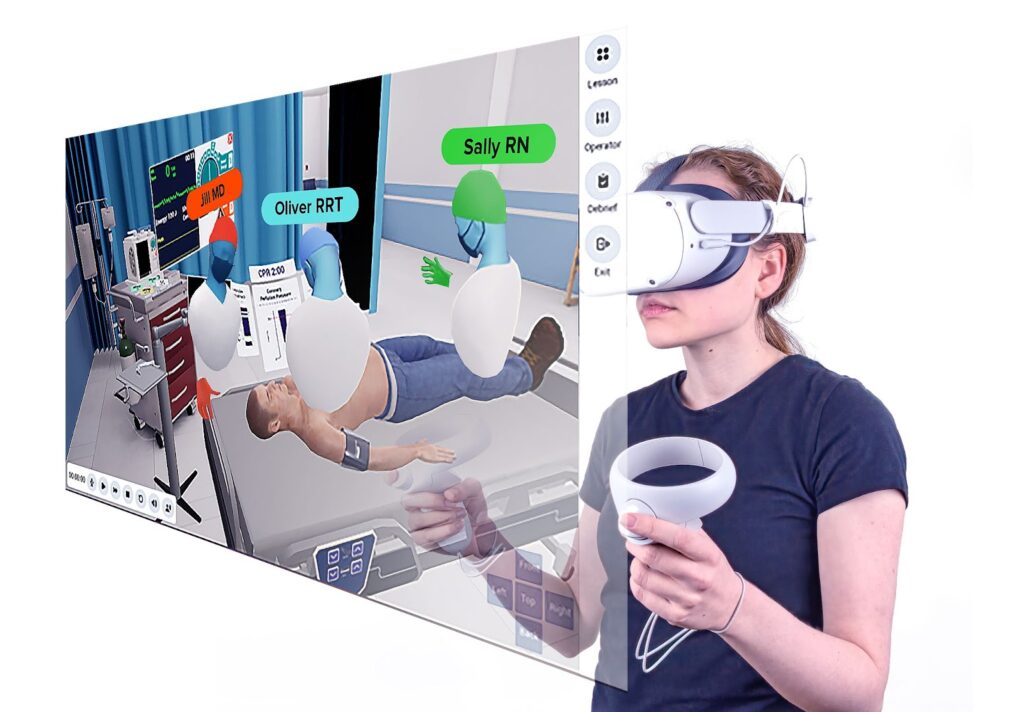
What Are Human Patient Simulators? Plus How VR Enhances Them
What Are Human Patient Simulators? Plus How VR Enhances Them
Simulation-based training is becoming the backbone of medical education. It helps doctors, nurses, and first responders handle high-stakes situations without risking real lives.
According to an Institute of Medicine (IOM) report, simulation-based training has significantly reduced medical errors. The report states that 60% to 90% of preventable deaths caused by medical errors were avoided when simulation was incorporated into training programs.
In this article, we’ll explore how human patient simulators improve medical training by reducing errors and saving lives. We’ll also uncover how VR enhances these simulators with cost-effective and flexible solutions.
What Is a Human Patient Simulator?
A human patient simulator (HPS) is a lifelike, computer-controlled manikin used to replicate real medical scenarios. These simulators mimic human anatomy and physiology. Healthcare professionals can practice procedures on these manikins to improve decision-making and teamwork in a safe environment.
For example, medical students can perform CPR on a human patient simulator. The simulator provides real-time feedback to show whether the chest compressions are deep enough or if the breathing is effective.
The history of patient simulators dates back to Sim One, developed by Dr. Stephen Abrahamson and Dr. Judson Denson at the University of Southern California. It was the first-ever computer-controlled patient simulator. In 2004, a survey of 34 nursing schools and six simulation centers showed that HPS was already widely used in training programs.
Types of Human Patient Simulators
Physical human patient simulators are categorized based on functionality and intended use. Let’s break down the main types:
Task Trainers
Task trainers are simulators designed to teach specific medical skills or procedures. These models often replicate one part of human anatomy so that users can practice repeatedly until they achieve precision.
It’s suitable for beginner-level training and cost-effective as compared to full-body simulators.
Examples:
- Arm models for IV placement.
- Airway trainers for learning intubation techniques.
- Surgical trainers for stitching wounds or laparoscopic skills.
Partial-Body Simulators
Partial-body simulators replicate specific body regions and are used for targeted training scenarios. They are especially valuable when full-body interaction isn’t necessary, but detailed anatomical accuracy is required.
Examples:
- Pelvic models for training in labor and delivery techniques.
- Torso simulators for CPR and defibrillation practice.
- Leg models for wound care and casting demonstrations.
- Head models for ear, nose, and throat procedures.
Full-Body Simulators
Full-body simulators are life-sized manikins that replicate full human anatomy and physical movements. They teach holistic medical skills, combining procedural knowledge with patient interaction.
Examples:
- Manikins designed for advanced patient handling or mobility training.
- Pediatric models for specialized child-focused care.
Advantages of Human Patient Simulators
The World Health Organization (WHO) strongly recommends using high-fidelity simulation in healthcare education. Studies show that it helps learners acquire, retain, and transfer both technical and non-technical skills more effectively.
Here are some of the advantages of human patient simulators:
Safe Learning Environment
According to WHO, unsafe medication practices and errors account for nearly 1% of global health expenditure. That may sound small, but it’s a staggering US$ 42 billion annually in monetary terms. Worse yet, thousands of preventable deaths are reported globally each year due to medical errors.
This is where human patient simulators make a difference. These advanced tools create a safe, controlled learning environment without putting real patients at risk.
HPS can replicate high-pressure situations like cardiac arrests or complex surgeries. It allows practitioners to experience managing rare events before they encounter them in reality.
Realistic Clinical Scenarios
Human patient simulators are designed to replicate real-world clinical conditions with incredible accuracy. Learners can practice in scenarios that feel almost indistinguishable from actual patient care.
For example, trainees can feel pulses, locate veins, and observe physiological changes like pupil dilation.
A systematic review focusing on undergraduate nursing students found that using HPS significantly improved their clinical reasoning skills. This means students not only learned the “how” of a procedure but also the “why,” Studies show that students engaging with HPS demonstrate higher enthusiasm and motivation to learn.
Improved Teamwork and Communication
Studies have consistently demonstrated simulation-based training, including human patient simulators.
Think about a high-stakes situation, like a trauma case or a cardiac arrest. Everyone in the room has to know their role, communicate clearly, and adapt on the fly. Simulators let you rehearse that dynamic before it happens in real life.
Consistent Training
HPS allows educators to create identical training scenarios for all learners. Whether it’s managing a cardiac arrest or performing an intubation, every trainee experiences the same conditions.
HPS allows consistent training to be delivered in multiple locations. For example, a hospital in a rural area can use the same simulation program as a teaching hospital in a major city, leveling the playing field for healthcare professionals everywhere.
How Much Does a Human Patient Simulator Cost?
Human patient simulators vary widely in price, typically ranging from $10,000 to $100,000. These costs depend on factors like the type of simulator, its technological features, the brand, and included support or training services.
Low-Fidelity Simulators
Price Range: $1,000–$15,000
Low-fidelity simulators are designed for basic skill development and focus on singular tasks or competencies, like lifting, patient positioning, or basic nursing care.
Mid-Fidelity Simulators
Price Range: $15,000–$35,000
These simulators add more features, such as the ability to simulate vital signs, physiological responses, and some mechanical movements. They are ideal for creating moderate clinical scenarios and enhancing procedural skills.
High-Fidelity Simulators
Price Range: $55,000–$100,000 or more
High-fidelity human patient simulators are at the top of the spectrum, replicating human anatomy, physiological responses, and behaviors to an impressive degree. These models can breathe, bleed, cry, and even respond to interventions like medications or surgeries in real time.
Limitations of Traditional Human Patient Simulators
Traditional human patient simulators have helped healthcare training, but they are not without their limitations. With the advent of virtual reality (VR) in healthcare training, many of these shortcomings are being addressed.
Lumeto is an industry-leading provider of virtual reality healthcare training and offers the largest library of no-code, customizable learning experiences.
Here are some of the key limitations of traditional human patient simulators.
High Upfront Costs
Traditional human patient simulators have high upfront and running costs. They have complex internal systems, including sensors and mechanical components that simulate realistic physiological responses.
Healthcare training institutes can maximize the value of their investments by augmenting them with virtual reality healthcare training.
Let’s break this down with a simple ROI calculation. Consider an institution that invests $100,000 in a high-fidelity simulator. On its own, it supports training for 10 learners per day due to physical constraints and scheduling.
For an additional $20,000, the institution can augment this simulator with virtual reality, expanding its training capacity to 30 learners daily. VR allows simultaneous participation without needing more physical hardware.
Over a year, this increased capacity translates to an additional 7,300 learners trained. If the cost per learner for traditional simulation is $100, adding VR reduces that cost to approximately $40 per learner.
Limited Scalability
While highly effective, their physical nature often limits traditional human patient simulators. A single simulator can only accommodate a small number of learners at a time. It is particularly challenging for larger institutions or programs with high enrollment.
As a result, learners may experience delays in receiving hands-on training, and institutions might struggle to maximize the value of their investment.
VR medical training enhances the capacity of existing programs by enabling learners to engage in virtual training sessions alongside their hands-on time with physical simulators. For example, while one group uses the physical simulator, another can practice complementary skills in a virtual environment. VR may also allow learners to prepare in advance for their hands-on sessions.
Physical Space Requirements
Simulation labs are expensive to set up and maintain, and the number of simulators that can be housed in a single location is limited.
- Simulation labs require rooms specifically designed to house human patient simulators.
- Extra space is needed for storing consumables (e.g., syringes, dressings)
- Many high-fidelity simulators require a control room where instructors can monitor.
- Labs need reliable power sources, network connectivity, and, in some cases, plumbing for specialized simulators.
Space constraints are a barrier to expanding training programs for smaller facilities or those in densely populated urban areas.

VR does not require dedicated simulation labs or extensive infrastructure. Instead, learners only need a headset and compatible human patient simulator software.
Lack of Scenario Flexibility
In traditional simulation, every time a new scenario is required, additional equipment may be necessary. Or the existing simulator might need costly upgrades. The customization options for many traditional simulators are also often limited.
This is where Lumeto VR dramatically enhances scenario flexibility. It offers more than 100 immersive learning experiences. What’s even more powerful is that Lumeto VR provides 800+ easy-to-use customization tools. Instructors can modify existing scenarios or create entirely new ones with minimal effort.
Here’s an example from Lumeto’s library, where students are engaged in a clinical scenario.
Accessibility Challenges
One of the biggest hurdles is their reliance on physical simulation labs, often in centralized facilities. Traveling to these locations can be time-consuming and expensive for learners in rural or underserved areas.
For learners with physical disabilities, traditional simulators may also present accessibility barriers.
Lumeto VR, when integrated into traditional simulation programs, addresses many of these challenges. Virtual reality allows trainees to access high-quality simulation experiences from anywhere. Learners in remote areas can participate in immersive scenarios without the logistical challenges associated with physical simulators.
The Future of Human Patient Simulators and VR Together
The future of healthcare training lies in the seamless integration of human patient simulators and virtual reality. The objective is no longer to treat simulation as a one-time tool for conducting isolated experiments or preparing for specific changes. Instead, simulation is becoming a routine part of the everyday learning and work environment.
Traditionally, simulations are instructor-driven, with pre-designed scenarios tailored to specific learning objectives. Moving forward, we anticipate a shift toward empowering medical students and trainees to design and build their simulation scenarios.
Integrating artificial intelligence (AI) into HPS and VR systems will create more dynamic training environments. Lumeto has introduced the industry’s first customizable conversational AI in VR for patient communication.
Traditional simulation systems rely on pre-scripted, uneditable dialog prompts. Lumeto’s AI-powered platform allows educators and trainees to create virtual patients with adaptive conversational abilities. Here’s an example in action:
Bring advanced healthcare training to your team. Book your demo with Lumeto.
Frequently Asked Questions About Human Patient Simulators
Are human patient simulators safe for repeated use?
Human patient simulators are built to be durable and withstand repeated use in training scenarios. However, regular maintenance and proper handling are essential to ensure their longevity and functionality.
What medical disciplines use human patient simulators?
Human patient simulators are used across various disciplines, including emergency medicine, nursing, obstetrics, pediatrics, surgery, and anesthesia simulation.
Can simulators be used for non-clinical skills training?
Yes, simulators are often used to train non-clinical skills such as communication, teamwork, and crisis management. These scenarios focus on soft skills critical for effective patient care and interprofessional collaboration.